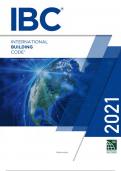@Seismicisolation
@Seismicisolation
,IBC
®
INTERNATIONAL
BUILDING
CODE®
A Member of the International Code Family®
@Seismicisolation
@Seismicisolation
, 2021 International Building Code
Date of First Publication: October 23, 2020
First Printing: October 2020
ISBN: 978-1-60983-955-0 (soft-cover edition)
ISBN: 978-1-60983-956-7 (loose-leaf edition)
COPYRIGHT 2020
by
INTERNATIONAL CODE COUNCIL, INC.
ALL RIGHTS RESERVED. This 2021 International Building Code® is a copyrighted work owned by the International Code
Council, Inc. (“ICC”). Without advance written permission from the ICC, no part of this book may be reproduced, distributed or
transmitted in any form or by any means, including, without limitation, electronic, optical or mechanical means (by way of
example, and not limitation, photocopying or recording by or in an information storage retrieval system). For information on use
rights and permissions, please contact: ICC Publications, 4051 Flossmoor Road, Country Club Hills, IL 60478. Phone 1-888-
ICC-SAFE (422-7233).
Trademarks: “International Code Council,” the “International Code Council” logo, “ICC,” the “ICC” logo, “International Build-
ing Code,” “IBC” and other names and trademarks appearing in this book are trademarks of the International Code Council, Inc.,
and/or its licensors (as applicable), and may not be used without permission.
T025567 PRINTED IN THE USA
@Seismicisolation
@Seismicisolation
, PREFACE
Introduction
The International Building Code® (IBC®) establishes minimum requirements for building systems using
prescriptive and performance-related provisions. It is founded on broad-based principles that make
possible the use of new materials and new building designs. This 2021 edition is fully compatible with
all of the International Codes® (I-Codes®) published by the International Code Council® (ICC®), includ-
ing the International Energy Conservation Code® (IECC®), International Existing Building Code® (IEBC®),
International Fire Code® (IFC®), International Fuel Gas Code® (IFGC®), International Green Construction
Code® (IgCC®), International Mechanical Code® (IMC®), International Plumbing Code® (IPC®), Interna-
tional Private Sewage Disposal Code® (IPSDC®), International Property Maintenance Code® (IPMC®),
International Residential Code® (IRC®), International Swimming Pool and Spa Code® (ISPSC®), Interna-
tional Wildland-Urban Interface Code® (IWUIC®), International Zoning Code® (IZC®) and International
Code Council Performance Code® (ICCPC®).
In addition to the codes themselves, the code development process brings together building pro-
fessionals on a regular basis. It provides an international forum for discussion and deliberation about
building design, construction methods, safety, performance requirements, technological advances
and innovative products.
The I-Codes, including the IBC, are used in a variety of ways in both the public and private sectors.
Most industry professionals are familiar with the I-Codes as the basis of laws and regulations in com-
munities across the US and in other countries. However, the impact of the codes extends well beyond
the regulatory arena, as they are used in a variety of nonregulatory settings, including:
• Voluntary compliance programs such as those promoting sustainability, energy efficiency and
disaster resistance.
• The insurance industry, to estimate and manage risk, and as a tool in underwriting and rate
decisions.
• Certification and credentialing of individuals involved in the fields of building design, construc-
tion and safety.
• Certification of building and construction-related products.
• US federal agencies, to guide construction in an array of government-owned properties.
• Facilities management.
• “Best practices” benchmarks for designers and builders, including those who are engaged in
projects in jurisdictions that do not have a formal regulatory system or a governmental
enforcement mechanism.
• College, university and professional school textbooks and curricula.
• Reference works related to building design and construction.
In addition to the codes themselves, the code development process brings together building pro-
fessionals on a regular basis. It provides an international forum for discussion and deliberation about
building design, construction methods, safety, performance requirements, technological advances
and innovative products.
Development
This 2021 edition presents the code as originally issued, with changes reflected in the 2003 through
2018 editions and further changes approved by the ICC Code Development Process through 2019. A
new edition such as this is promulgated every 3 years.
This code is intended to establish provisions that adequately protect public health, safety and wel-
fare; that do not unnecessarily increase construction costs; that do not restrict the use of new materi-
als, products or methods of construction; and that do not give preferential treatment to particular
types or classes of materials, products or methods of construction.
@Seismicisolation
@Seismicisolation
2021 INTERNATIONAL BUILDING CODE® iii




